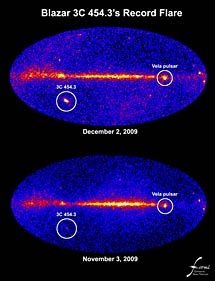
Handy Links
SLAC News Center
SLAC Today
- Subscribe
- Archives: Feb 2006-May 20, 2011
- Archives: May 23, 2011 and later
- Submit Feedback or Story Ideas
- About SLAC Today
SLAC News
Lab News
- Interactions
- Lightsources.org
- ILC NewsLine
- Int'l Science Grid This Week
- Fermilab Today
- Berkeley Lab News
- @brookhaven TODAY
- DOE Pulse
- CERN Courier
- DESY inForm
- US / LHC
SLAC Links
- Emergency
- Safety
- Policy Repository
- Site Entry Form

- Site Maps
- M & O Review
- Computing Status & Calendar
- SLAC Colloquium
- SLACspeak
- SLACspace
- SLAC Logo
- Café Menu
- Flea Market
- Web E-mail
- Marguerite Shuttle
- Discount Commuter Passes
-
Award Reporting Form
- SPIRES
- SciDoc
- Activity Groups
- Library
Stanford
Around the Bay
Fermi Telescope Sees Brightest-ever Blazar Flare
A galaxy located billions of light-years away is commanding the attention of the Fermi Gamma-ray Space Telescope and astronomers around the globe. Thanks to a series of flares that began September 15, the galaxy is now the brightest source in the gamma-ray sky—more than ten times brighter than it was in the summer.
Astronomers identify the object as 3C 454.3, an active galaxy located 7.2 billion lightyears away in the constellation Pegasus. But even among active galaxies, it's exceptional.
"We're looking right down the barrel of a particle jet powered by the galaxy's supermassive black hole," said Gino Tosti at the National Institute of Nuclear Physics in Perugia, Italy. "Some change within that jet—we don't know what—is likely responsible for these flares."
Blazars, like many active galaxies, emit oppositely directed jets of particles traveling near the speed of light when matter falls toward their central supermassive black holes. What makes a blazar so bright in gamma rays is its orientation. In this case, one of the jets happens to be aimed straight at Earth.
Most of the time, the brightest persistent source in the gamma-ray sky is the Vela pulsar, which at a distance of about 1,000 light-years lies practically next door.
"3C 454.3 is millions of times farther away, yet the current flare makes it twice as bright as Vela," said Lise Escande at the Center for Nuclear Studies in Gradignan, near Bordeaux, France. "That represents an incredible energy release, and one the source can't sustain for very long."
According to Massimo Villata at Italy's Torino Observatory, 3C 454.3 also is flaring at radio and visible wavelengths, if less dramatically. "In red light, the blazar brightened by more than two and a half times to magnitude 13.7, and it is also very bright at high radio frequencies."
The Fermi telescope team is alerting astronomers to monitor the event over as broad a range of wavelengths as possible. "That's our best bet for understanding what's going on inside that jet," Tosti said.
—Francis Reddy, NASA Goddard Space Flight Center
SLAC Today, December 9, 2009
